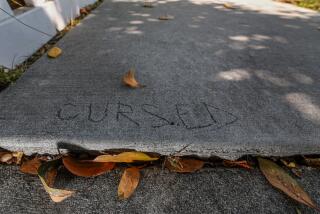Wheelchairs Can’t Get to Freeway Phones : When a Call for Help Is Out of Reach
- Share via
Getting a flat tire on the freeway is no fun for anyone, but for someone in a wheelchair, it’s a real hassle.
“I had a flat tire recently,” said Tom Komar, an architect who was left a quadriplegic by a 1980 car accident. “I couldn’t use a call box, so I had to ruin my wheel rim by driving all the way to a gas station.”
Since August, 550 call boxes have been installed on San Diego freeways, and none of them can be reached by many of the physically handicapped. A 6-inch-tall, curb-like barrier prevents wheelchair access.
Another 550 of the boxes are to be installed by February.
“We’re looking into a solution to the (handicapped) problem,” said Ralph Thielicke, project manager for the San Diego Service Authority for Freeway Emergencies, a committee created by state law to oversee the call box project here.
SAFE has hired Komar to design the most logical way to make the boxes accessible to wheelchairs.
“We’re trying to move on this relatively quickly so that we can make the changes on the ones that are currently being installed,” Komar said.
An environmental change, such as building ramps along freeway curbs, would probably be the most effective solution, he said, but SAFE is considering electronic alternatives as well.
One would be to provide the handicapped with cellular car phones; another would be to give them gadgets similar to garage door openers, which could activate the call boxes.
“Hey, if they want to buy me an expensive cellular car phone, I’ll take it, but I don’t think that’s the best solution,” said Elizabeth Bacon, director of San Diego State University’s Disabled Student Services, who has been working on the project with SAFE. She said she doesn’t like the idea of garage door openers, either.
“What if a disabled person is driving through San Diego from out of town, and their car breaks down?” she said.
She also questions the feasibility of keeping the device in the car. “What happens if kids play with it in the back of the car and the call boxes keep going off, and pretty soon the Highway Patrol ignores the calls?”
Bacon said an environmental design, such as ramps, would make the boxes useful to everyone with a physical disability, whether permanent or temporary.
“Seventy percent of us will have a mobile limitation sometime in our lives, lasting six months or more,” she said. “You don’t necessarily know when you’re going to need to use a call box.”
Thielicke said that, although SAFE is considering installing ramps, that modification would cost several thousand dollars and would not be totally effective because some stretches of freeway, such as Interstate 8 in Mission Valley, are steep and have extremely narrow shoulders that cannot accommodate wide wheelchairs.
He said the California Highway Patrol receives about 11,000 calls a week from motorists statewide who are stuck on freeways. The $3.2-million call-box project is being financed by a $1 charge on each San Diego car registration.
Los Angeles County has had call boxes on freeways at quarter-mile intervals for 10 years. Peter De Hann of the Los Angeles County Transportation Commission said the agency has received many complaints from the handicapped and is working on adapting the system.
More to Read
Sign up for Essential California
The most important California stories and recommendations in your inbox every morning.
You may occasionally receive promotional content from the Los Angeles Times.













